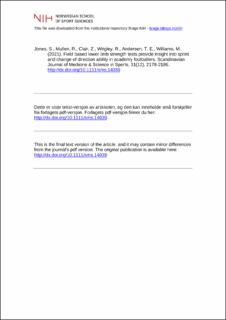| dc.contributor.author | Jones, Steven | |
| dc.contributor.author | Mullen, Rich | |
| dc.contributor.author | Clair, Zoe | |
| dc.contributor.author | Wrigley, Russ | |
| dc.contributor.author | Andersen, Thor Einar | |
| dc.contributor.author | Williams, Morgan | |
| dc.date.accessioned | 2022-09-14T10:36:13Z | |
| dc.date.available | 2022-09-14T10:36:13Z | |
| dc.date.created | 2021-10-19T12:00:35Z | |
| dc.date.issued | 2021 | |
| dc.identifier.citation | Scandinavian Journal of Medicine & Science in Sports. 2021, 31(12), 2178-2186. | en_US |
| dc.identifier.issn | 0905-7188 | |
| dc.identifier.uri | https://hdl.handle.net/11250/3017773 | |
| dc.description | I Brage finner du siste tekst-versjon av artikkelen, og den kan inneholde ubetydelige forskjeller fra forlagets pdf-versjon. Forlagets pdf-versjon finner du på onlinelibrary.wiley.com / In Brage you'll find the final text version of the article, and it may contain insignificant differences from the journal's pdf version. The definitive version is available at onlinelibrary.wiley.com. | en_US |
| dc.description.abstract | Conducting field-based strength assessments is embedded within football academy development processes. Yet, there is a limited understanding of how hip and groin strength assessments relate to vital game-based tasks such as sprinting and change of direction (COD) performance. Our aim was to explore field-based strength assessments and their relationships with both sprint and COD performance in male academy footballers. Participants (n = 146; age 14.2 ± 2.2 years; stature 166.3 ± 15.4 cm; body mass 55.6 ± 15.6 kg) performed maximal countermovement jump (CMJ), Nordic hamstring strength (NHS), isometric hip adductor (ADD)/abductor (ABD), 5 m, 10 m, 20 m sprints, and modified 505 agility test. All strength measures were allometrically scaled to account for body weight. Between-limb differences were reported as imbalance scores. Principal component analysis reduced sprint and COD variables to a single “running ability” component score. Scaled strength and imbalance, when controlled for age, were associated with “running ability” (adjusted R2 = 0.78, p < 0.001). Significant effects on “running ability” included the following: age, CMJ impulse, NHS, and hip-ADD. When the sprint and COD variables were explored independently, age and CMJ-impulse were featured in all sprint and COD models. For 10 m and 20 m sprint distances, hip-ADD emerged as a significant effect. Mean 505 performance was explained by age, CMJ-impulse, hip-ADD, but also with the addition of NHS. Our findings suggest that insight into the underpinning strength qualities of “running ability” of academy footballers can be obtained from a suite of field-based tests. | en_US |
| dc.language.iso | eng | en_US |
| dc.subject | change of direction | en_US |
| dc.subject | eccentric strength | en_US |
| dc.subject | impulse | en_US |
| dc.subject | soccer | en_US |
| dc.subject | sprint | en_US |
| dc.subject | youth | en_US |
| dc.title | Field based lower limb strength tests provide insight into sprint and change of direction ability in academy footballers | en_US |
| dc.title.alternative | Field based lower limb strength tests provide insight into sprint and change of direction ability in academy footballers | en_US |
| dc.type | Peer reviewed | en_US |
| dc.type | Journal article | en_US |
| dc.description.version | acceptedVersion | en_US |
| dc.source.pagenumber | 9 | en_US |
| dc.source.journal | Scandinavian Journal of Medicine & Science in Sports | en_US |
| dc.identifier.doi | 10.1111/sms.14039 | |
| dc.identifier.cristin | 1946986 | |
| dc.description.localcode | Institutt for idrettsmedisinske fag / Department of Sports Medicine | en_US |
| cristin.ispublished | true | |
| cristin.fulltext | postprint | |
| cristin.qualitycode | 2 | |
